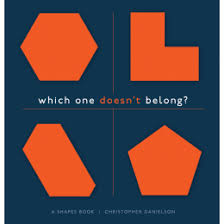Which One Doesn't Belong?

The idea of comparing groups of items looking at similarities and differences has been explored by many math educators. Christopher Danielson, the author of the blogs Overthinking my Teaching and Talking Math With Your Kids has taken this idea to new heights. Inspired by Sesame Street's "One of these things in not like the others", Danielson wrote the book Which One Doesn't Belong. In this routine students are asked to look at all four images in each of the quadrants and asked to share their reasoning as to "Which One Doesn't Belong and Why?" The great thing about this routine is that there are no wrong answers, as long as the student's reasoning is true. The focus is not on the answer, but on the student being able to communicate his/her reasoning/justification of their choice.
How do I use it with my students?
I typically begin by asking the students to take some independent time to think about the images. Students need time to process their own ideas before considering others. Sometimes my next step is a pair-share following the thinking time. Then I ask for students to volunteer their ideas.
Guiding Questions:
What do you notice?
What makes all the items alike?
What makes them different?
Which one doesn’t belong?
Can you share your reasoning to justify your answer?
Guiding Questions:
What do you notice?
What makes all the items alike?
What makes them different?
Which one doesn’t belong?
Can you share your reasoning to justify your answer?
What is the learning?
|
The potential learning intentions:
Focuses attention on attributes of number and number relationships Engages students in problem solving Encourages using Mathematical vocabulary Show the image and let the students discuss. Supporting websites/blogs:Teacher Resources:
Website: http://wodb.ca/index.html Twitter Hashtag: #wodb https://twitter.com/search?q=%23wodb&src=typd |
WODB Handout - Created by Chris Hunter and Christopher Danielson
| wodb_handout.pdf | |
| File Size: | 418 kb |
| File Type: | |
Christopher Danielson has written a "Which One Doesn't Belong" book focused on Shapes that has an excellent teacher's guide.



